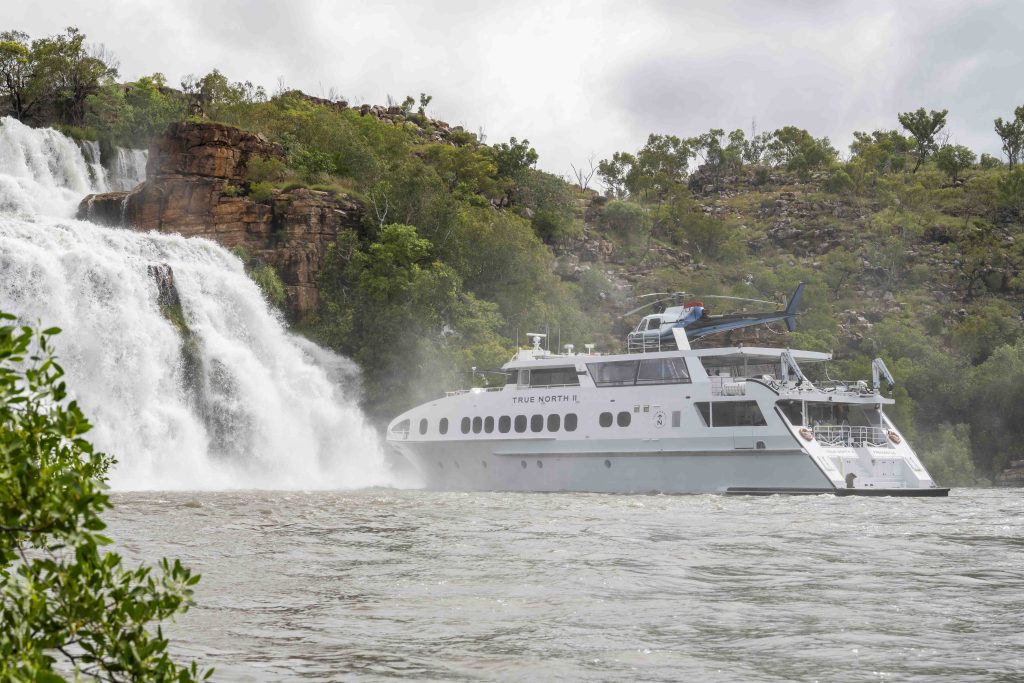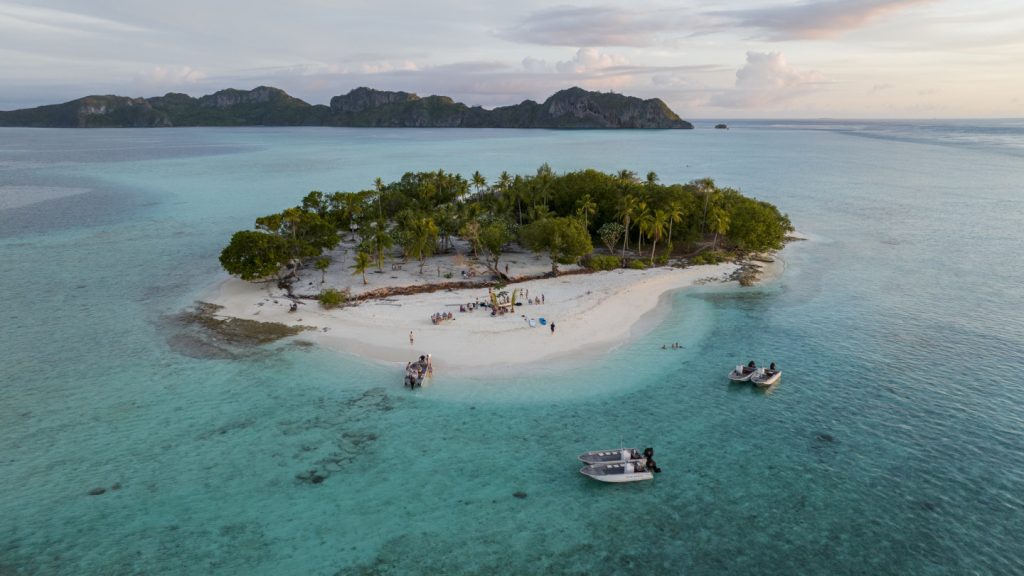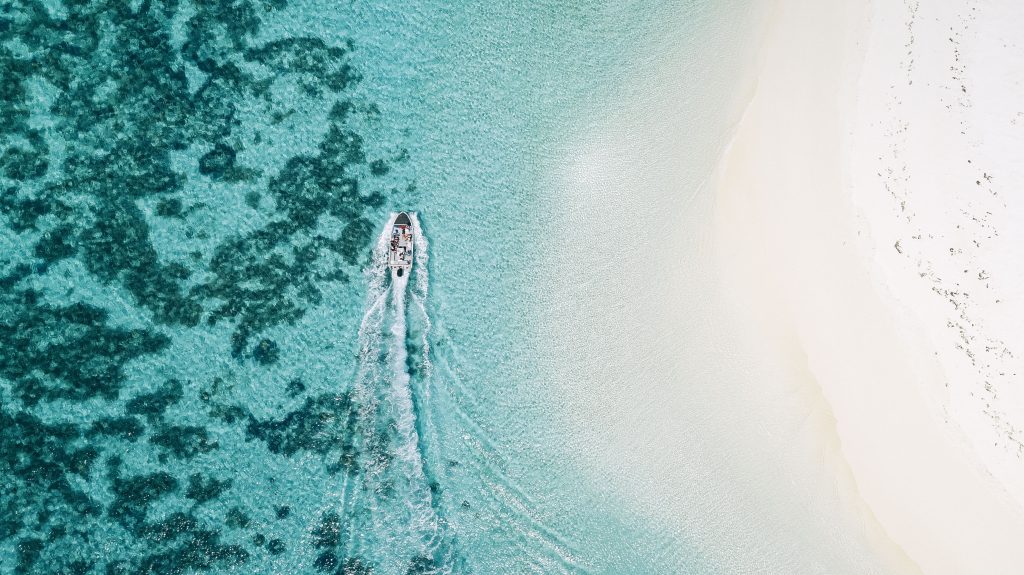gourmettraveller.com.au | Wild Luxury: Boarding True North in The Kimberley – NIKKI WALLMAN
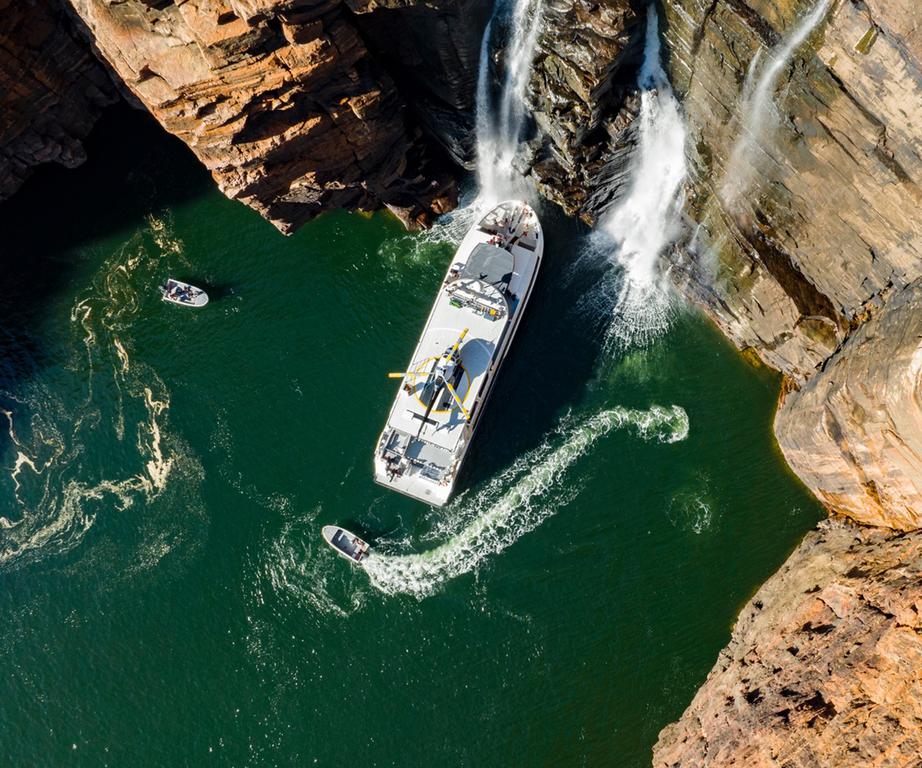
A voyage of discovery through the jaw-dropping wonder of the Kimberley region’s Buccaneer Archipelago aboard the True North II can make you feel very, very small, in the best possible way.
I’m sipping steaming coffee in the soft unfurling of the day’s first rays, barefoot and tousle-haired on the bow of the True North II. We’re slicing across the pure, mirrored surface of an endless blue, diamonds of dancing light chasing us on the water as we disappear between majestic ridges of glowing Kimberley rock into this vast and true wilderness.
If there’s such a thing as peak Australia, it might lie here, within this 1.8 billion-year-old landscape: this rugged testament to the massive, ancient collision and rearrangement of rock, the groaning grandeur of giant building blocks locked at improbable angles along the coastline a reminder of the massive tectonic power that lies beneath us all.
This wild place, full of wild things: deadly saltwater crocs, mesmeric manta rays, sharks, turtles, bottlenose and snubfin dolphins, dugongs, Spanish mackerel, barramundi; around a third of all our bird species, including red-headed honeyeater, osprey, azure kingfisher, white-bellied sea eagle.
This almost inconceivable vastness: roughly the size of Germany, with its scarcity of humans (under 40,000), and its arching history – at least 40,000 years – of Indigenous habitation and protection of the land, documented in countless galleries of ancient Gwion Gwion and Wandjina rock art.
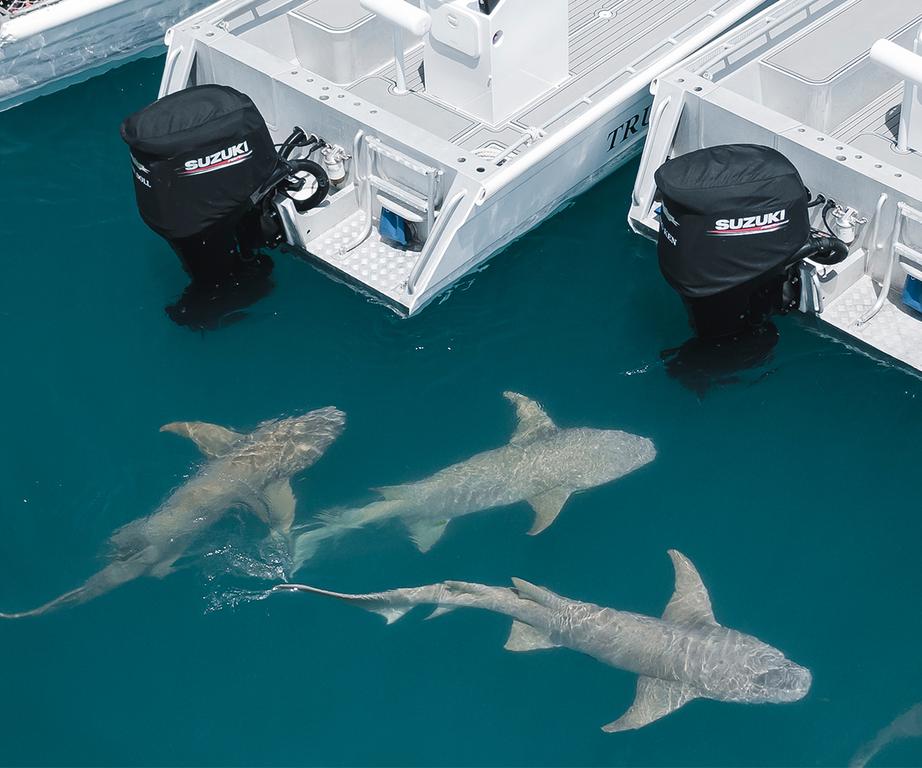
This startling oceanography: the heart-thumping, force-field immensity of its tidal range – more than 11 metres – causing life-filled shelves of reef to rise from ocean, waterfalls to run sideways, jaws to hit the floor. Everything here is governed by these monster tides, including our small group’s movements for the next four days.
Could there be a truer testament to the devastating natural beauty of our time-worn, hard-loved land than the Kimberley coastline? And could there be a better way to see it than in the hands of True North Adventure Cruises? First breathed into being by pioneering adventurer (and 2016 OAM recipient) Craig Howson in 1987, True North today offers an innately Australian sense of luxury: barefoot (literally: no shoes on the boat), laidback, with activities tailored to your preferences but geared towards a communal sense of thrilling discovery.
True North and True North II are “adventure-platforms,” according to the literature, “vehicles designed to deliver our guests into the very heart of wilderness”. The guest-to-staff ratio is high (14 crew to a maximum of 22 passengers on the more intimately sized True North II); the young, fun crew dart about like minnows, refilling glasses, tidying rooms. They’re quick studies in each guest’s personality and preferences: social butterfly or introvert; chardonnay or cab sauv; fishing tragic or sunset-chaser.
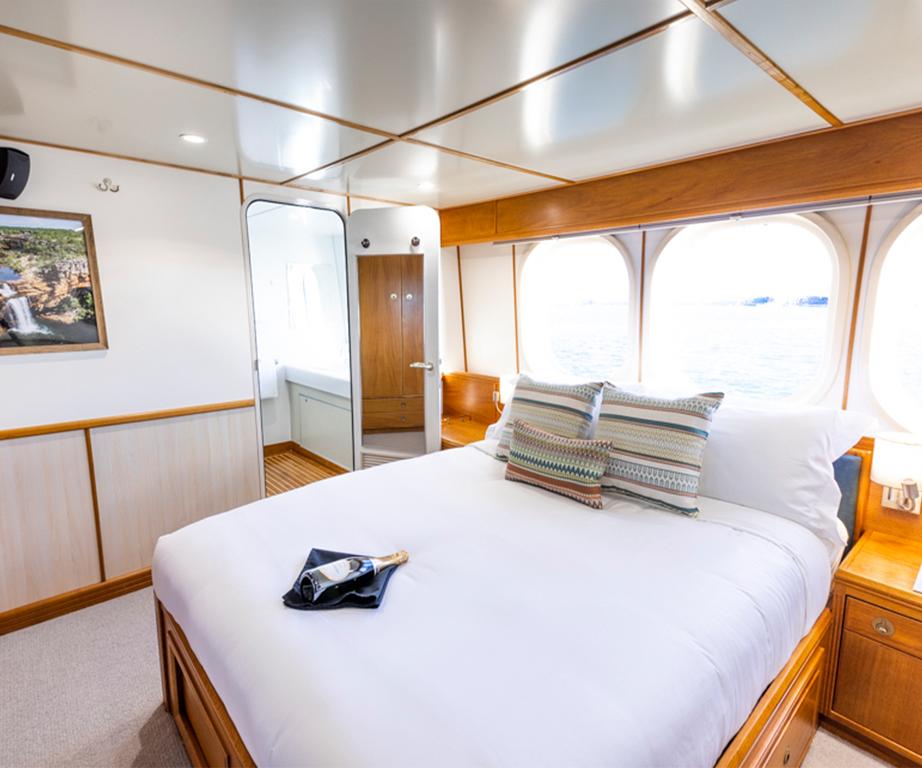
My room, Ord, nestles a queen-sized bed against the porthole window, with desk, ample storage space and small ensuite. At seven square metres, it’s comfy and cosy – bigger rooms on board are 12 square metres, and rooms on True North are up to 18 square metres – the more compact nature allowing for lower pricing than True North.
But this is all really about a different sense of luxury: rarefied, insightful access to places others can’t reach. Purpose-built for adventure cruising in the Kimberley, an on-board helicopter and adventure boats broaden both ships’ horizons even further. Too many bells and whistles tempting us to stay onboard would feel disingenuous, I think, gazing into the beckoning blue.
The previous afternoon, we’d boarded True North II from Broome’s Cable Beach. Tanned crew extended steady hands, followed by glasses of bubbly and canapés as we commenced our overnight steam around Cape Leveque towards the 800-plus islands of the Buccaneer Archipelago (the Kimberley boasts more than 2600 islands), and partly into Dambimangari Country. We’re a varied bunch – some sailing solo, mostly couples, a gaggle of adventurous girlfriends – getting to know each other around the communal dining table over a “surf and turf” dinner of blushing eye fillet, prawns and herbed butter (preferences and dietaries are tailored to).
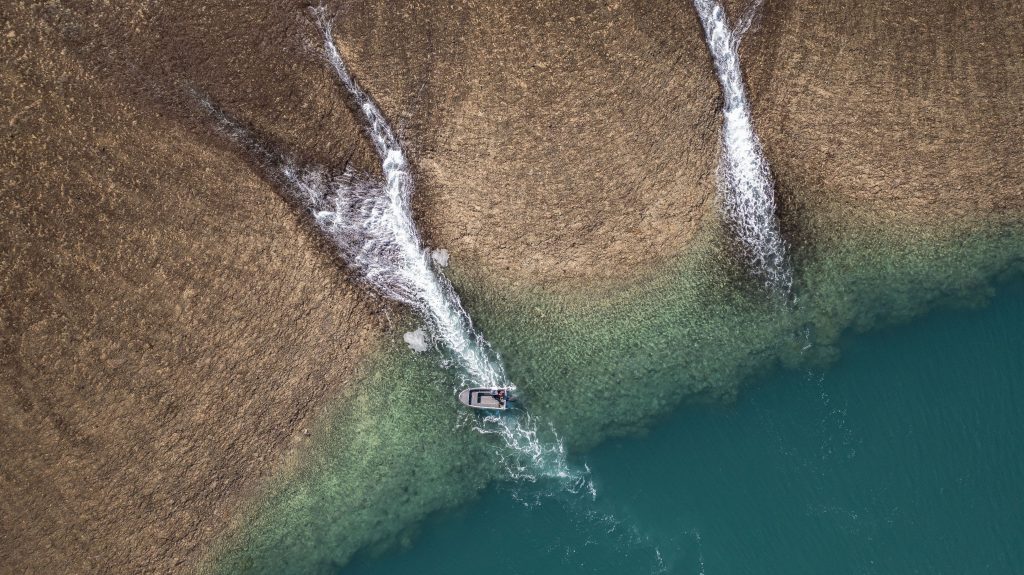
The next few days will offer a beautifully framed glimpse of this unimaginably massive landscape. I’ve never felt smaller, in the best possible way; a mere nanosecond in a yawning universe. The water here hides dangers dizzying in multitude and scope. It goes from glassy calm to potential disaster within minutes. Apparently, the crocs sometimes snake along under the shade of a boat. Do not, do not put your hands in the water, or even over the side, our guides tell us, repeatedly.
“You’ll probably get the feeling that we’re full of it,” says genial on-board naturalist Tim. This time of year (October) he explains, “you tend not to see them sunning themselves on the banks” as much. But they’re here (and we do see them). And of all the croc species worldwide, the saltie – which grows up to six metres – is the largest and most aggressive. “Go Australia,” Tim intones, drily. We all laugh. Nervously.
It’s hard, at first, to put these warnings out of mind when offered a refreshing dip in a freshwater waterhole our first morning, gliding across Dugong Bay before clambering up sun-beaten rocks to a scenic, carefully chosen swimming spot. Some climb ledges to plunge like fishing lures into the water. Others, like me, edge in: pause, edge again, before surrendering to the delicious, cooling deep.
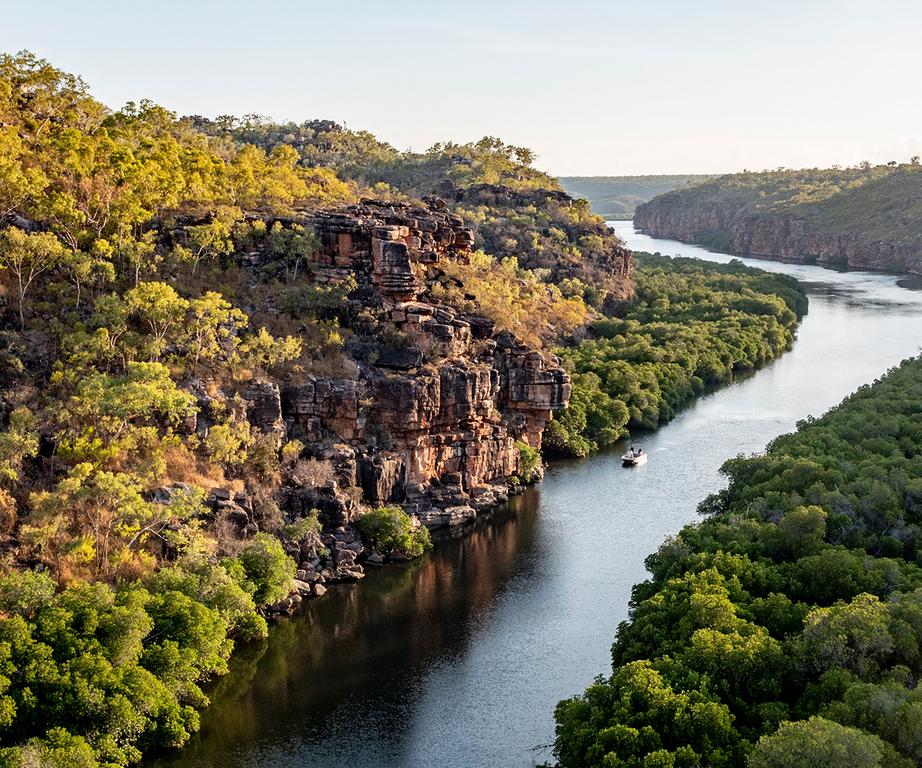
Back on deck, a lunch of Sichuan-spiced confit duck leg slides obligingly off the bone, crowning a coconutty Indonesian urap sayur salad. Wines span Margaret River to Italy, with some reserve bottles on offer alongside Champagnes. Afternoon canapés may involve crab and fennel tartare on homemade crackers, topped with avocado mousse (perfect with a Kimberley Rose cocktail). Breakfasts range from chilli scrambled eggs to Broome mango pancakes; lunch is often a refreshing salad, substantial enough for adventure-stoked appetites. Dinners include beef ragù with tagliatelle, and sticky pork belly with Asian salad and coconut rice; all served with a hearty side of good-natured banter.
My first chopper ride takes in Talbot Bay and the Horizontal Waterfalls; an epic taste of the sheer, breathless scope afforded us on this trip. The dangers below fade into a milky oceanic palette: swirling swathes of ocean, blooming clouds of churning sand, brushstroke blobs of green mangroves. We approach the waterfalls: two narrow channels between soaring ridges of stratified rock, ending in gnarled giants’ knuckles pressing down into the blue. The tidal waters force their way through the gaps, spitting toothpaste-like torrents. Later we board tenders to get a closer look, the churning water tracing whirlpools and smacking foamy kisses against the sides of our boat.
The quieter waters of Talbot Bay bring reflection; tree-dotted ridges undulating in rhythmic waves, saturated afternoon sun flickering like a silent movie reel. The countless layers of rock resemble pages in a thick book, dropped in the swimming pool, all crumpled and re-set; part of a story older than we can begin to fathom.
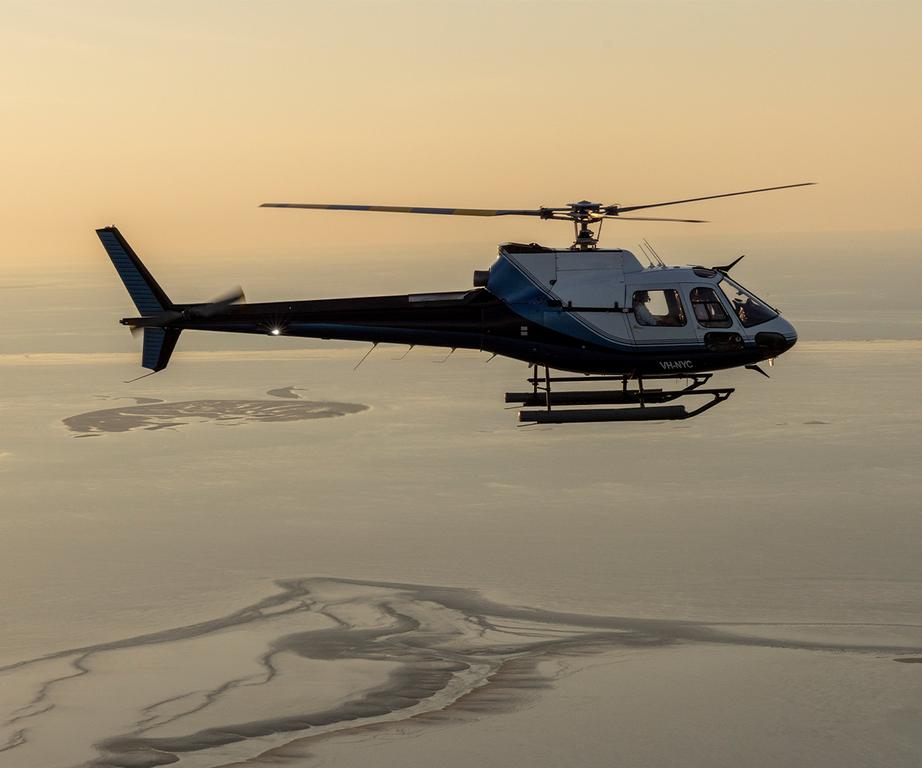
Next morning at Montgomery Reef reveals sky smudged with sea, the air and water soft and pastel-hued. Squinting, I see the massive, ancient reef seemingly rising from the ocean as colossal amounts of seawater drain off the reef with the pull of the tide.
We soar above in the chopper, struck silent by the discombobulating beauty of it all. A cerulean channel cuts a swathe between ridges of reef like an enormous, flowing spine, the reef as lungs, tiny inlets like bronchiole feeding the larger veins of life-filled water. Then it’s our turn at sea level, water like white lava flowing furiously towards us, the spray splashing my face. Turtles breaststroke by; a sea snake pokes its head up like a periscope.
We board the chopper again, soaring Bond-like through riverine channels before landing at a picturesque spot along the Sale River, where a freshwater pool beckons and trees burst from seemingly solid rock. Later, during sundowners atop a rugged cliff overlooking monolithic islands, one of our group heralds it as the best day of his life: “I’m still processing it all,” he says, eyes glistening. He quietly takes a solo perch, contemplating the campfire-coloured sun’s descent; none of us are immune to the magic of the moment.
The highlight of our last day comes at Silica Beach, where powdery white sand crunches like snow underfoot. The crew arrange a pop-up bar on the beach; others moor along the rocks and water, on vigilant croc-watch. We wade in, faces upturned; mooch happily in that impossibly jewel-coloured water, marvelling at our luck. There are no roads to this beach, no other visitors; no bars except the one the crew conjures and dismantles, leaving no trace; like we were never even here at all.

